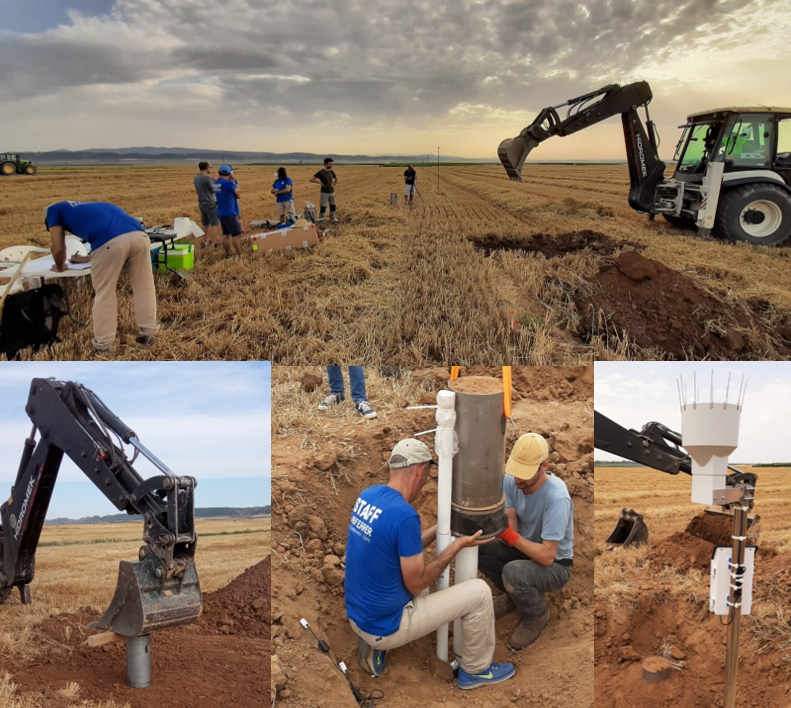November 2023: Final conference with stakeholders
The final conference of IDEWA took place at the University of Lleida in November 2023. It included a consortium meeting on the 8th November and a participative seminar with stakeholders on the 9th November. The consortium meeting was an opportunity to review the main scientific achievements of the project and to plan for the future. The stakeholder meeting was a great success, bringing together around 40 people including the farmers most involved in IDEWA, irrigation agencies (Canal A-B, Canals d’Urgell), basin agencies (CHEBRO, ABHT), civil engineering departments (Infraestructures de Catalunya) and other regional institutions (ACA, ICEA Seccio de Sols, COEAC Comissio de l’Aigua). An effort was made to present the main results of the project in a concise, easy-to-understand way and each presentation was followed by a wide-ranging discussion with stakeholders.
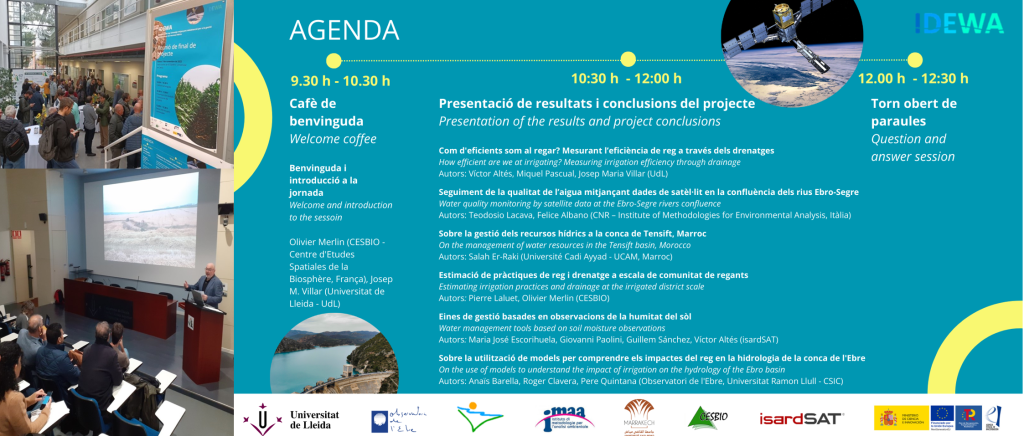
March 2023: Outreach to stakeholders
On March 17, we were invited to present the IDEWA project in Mollerussa (Lleida), to the actors of the agricultural world. You can see the full programme here.

March 2023: Outreach article about IDEWA
A Dossier Tècnic describing the IDEWA project was published by the Ruralcat community. Remote sensing is a very powerful technology that allows continuous observation of the territory and monitoring of future actions. However, such monitoring is jointly based on the use of models that mimic real observations made in the field. You can read the whole article in the Dossier Tècnic #121 (pp. 34-37)
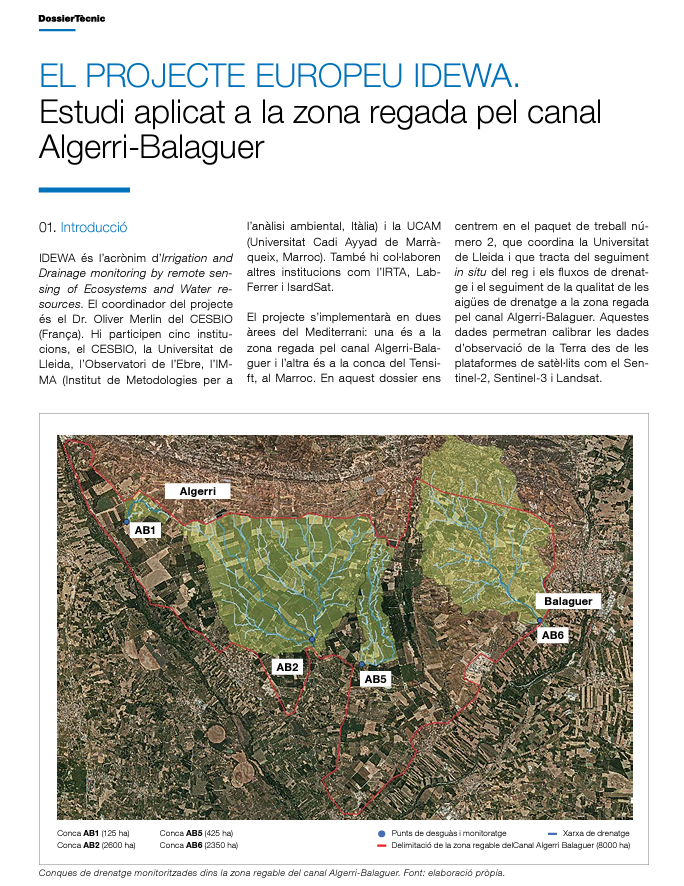
January 2023: An online tool to observe river water quality from space
A Google Earth Engine App is currently in preparation in the framework of the IDEWA project by the IMAA partner. This tool will allow for the generation of Chlorophyll-a (Chl-a) and Total Suspended Sediment (TSM) maps on the basis of Sentinel 2 and Landsat 8-9 satellite data acquisitions. The Ebro Segre rivers confluence close Mequinenza city, downstream the Algerri-Balaguer district outlet, is the investigated site.
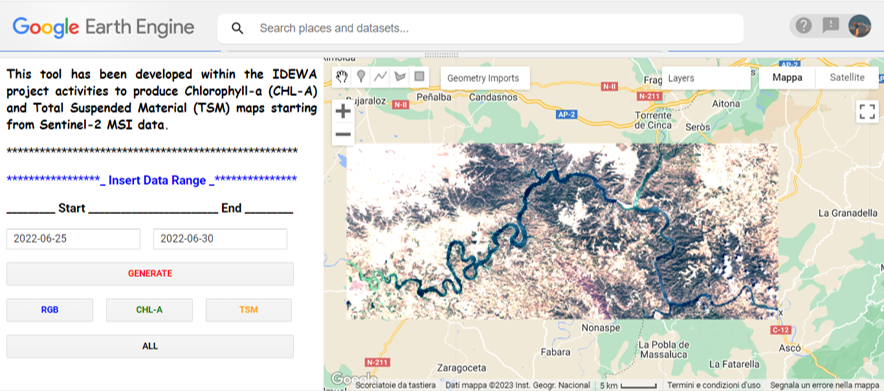
December 2023: Outreach article on the management of fertilization
“Tierras” published our divulgative article that UdL made of the management of fertilization in Algerri-Balaguer. The article presents a methodology for the evaluation of nitrogen management in an irrigable area, combining the knowledge of farmers and technicians of the area to be studied with the use of Geographic Information Systems (GIS) and open data from crop maps. In this way it is possible to know how fertilization is being carried out and if there is room for improvement.
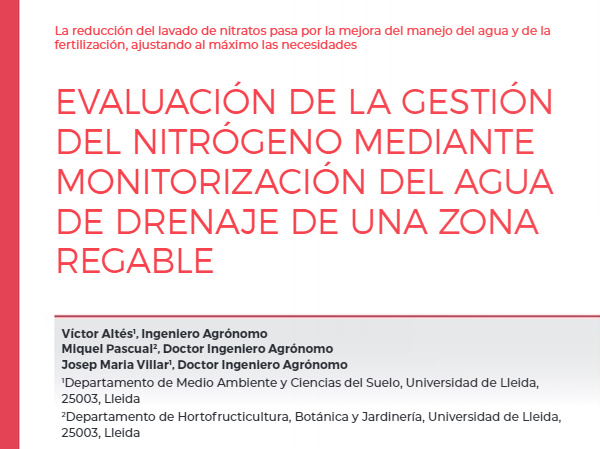
December 2022: Participative seminar in Lleida
The second IDEWA participative seminar took place in Albesa near Lleida on the 2nd December 2022. Thanks to the close connection of UdL researchers to the Comunitat de regants del Canal Algerri-Balaguer, more than 20 farmers participated in that meeting. The objective was to present them the IDEWA objectives and the main results obtained until then, and to interact with them about their irrigation and fertilization practices through an online interactive questionnaire. At this stage of the project, we were able to show an estimate of the actual water use efficiency over the entire irrigation district and to compare it with the potential water use efficiency. Our scenarios, taking into account both the crops requirement (minimum water use for an optimal yield) and the soil leaching requirement (+4%) over the area, indicate that the Comunitat de regants could save about 12% of irrigation water, corresponding to a cost of 0.5 million euros per year. The exchange was very fruitful and farmers freely expressed their view point and experience. One of the needs expressed during the seminar was the modernization of the water supply systems at the farm level so that farmers can manage the irrigation timing by themselves. Such information will be essential to help co-build strategies with farmers and the other stakeholders over Algerri-Balaguer for optimizing the irrigation and fertilization practices, especially for determining in reality by how much and when irrigation water and nutrients can be saved from the farm to the irrigation district scales.

November 2022: Participative seminar in Marrakech
A participative seminar with several farmers in the Haouz plain was organized in Marrakech on the 11th November 2022. Most of the IDEWA members were in Marrakech at that time thanks to the GESOC (https://gesoc2022.sciencesconf.org/) symposium, which took place at the Université Cadi Ayyad de Marrakech from 7th to 10th November. The preparation and facilitation of the meeting by the IDEWA team benefited from the great help of Aouade Ghizlane (former UCAM PhD student and now start-up entrepreneur in the field of agricultural water quality), Zoubair Rafi (postdoctoral fellow at UCAM working on the SATIRR online decision support tool) and Marielle Montginoul (INRAE economist researcher at G-EAU laboratory in Montpellier). The program of the participative seminar included a questionnaire to farmers, followed by several presentations about IDEWA objectives and the quantification of water use efficiencies and the drained water quality at our experimental sites. This seminar was the first of two successive IDEWA participative seminars whose objective will be to co-build with farmers and local stakeholders strategies for optimizing irrigation and fertilization practices in terms of water productivity, soil salinization and ground water quality issues. Each question of the questionnaire was an occasion for farmers to interact with the IDEWA team and between them about various (economical, knowledge, logistical, etc.) issues related to their practices.
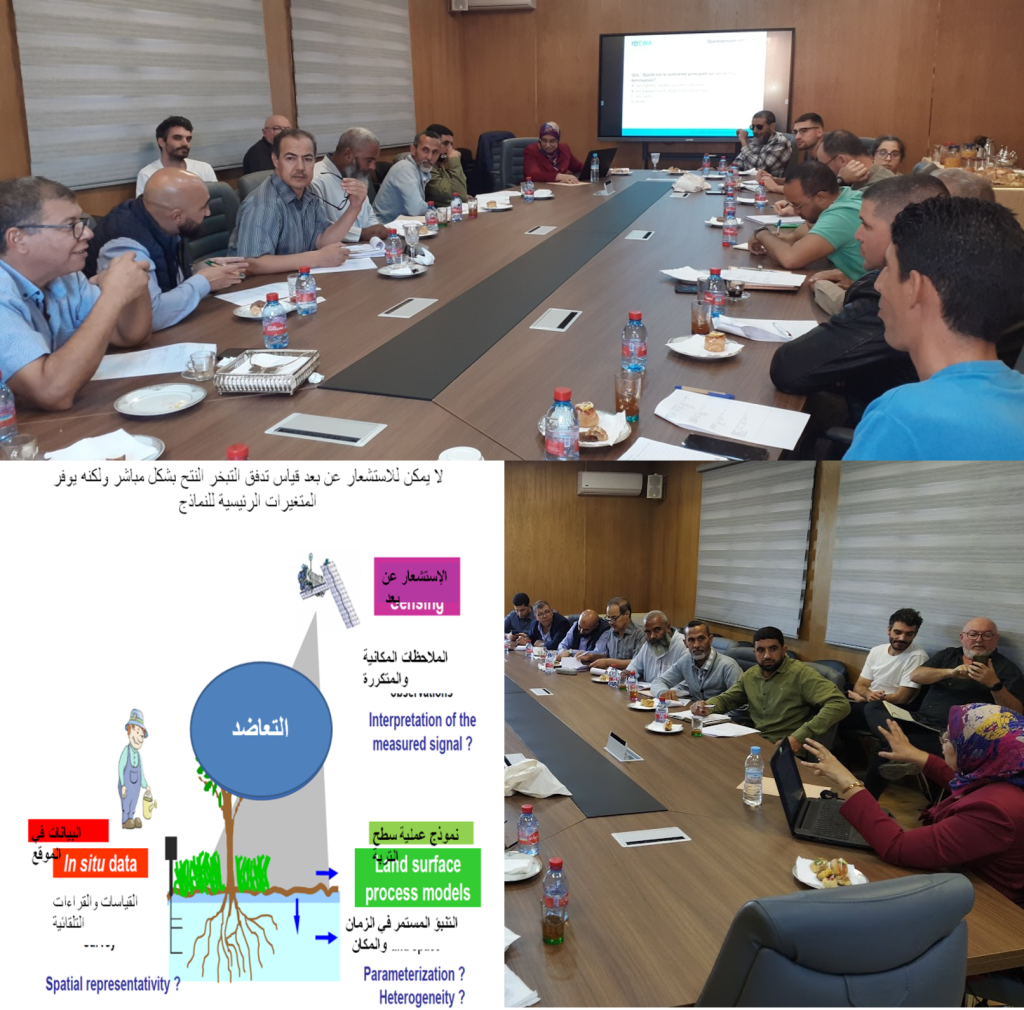
May 2022: Water sampling the in Ebro and Segre rivers
On May 26th, the first IDEWA measurement campaign was carried out to collect sub-surface water samples and radiometric measurements along the Ebro and Segre rivers. These collected data, together with the others that will be acquired in the next measurement campaigns, will be useful for calibrating/validating satellite-based standard algorithms for the retrieval of the main in-water optical constituents, such as Chlorophyll-a (Chl-a) and Total Suspended Matter (TSM).
Clear sky conditions allowed for acquiring water leaving radiances in the 350-2500 nm spectral domain by the ASD FieldSpec Pro spectroradiometer. Sub-surface water samples were concurrently collected in each planned station for subsequent laboratory analysis for Chl-a and TSM concentration retrievals.
A total of 14 stations, all located on the west side of the Mequinenza Dam, were fully sampled, to investigate different branches of the Segre and Ebro rivers.
Researchers of IMAA-CNR and University of Lleida were jointly involved in the campaign, both in its organization and realization, trying to face and manage all the potential issues also in view of the next campaigns.

May 2022: Installation of two METER Drain Gauge G3 lysimeters in an olive field near Marrakech
On May 16th and 17th, two METER Drain Gauge G3 lysimeters were installed in an irrigated olive field near Marrakech (Agdal site) to measure the deep percolation (DP) caused by rainfall and/or excess of irrigation. Some parts of this olive field are irrigated with a surface drip irrigation system, and others with an underground drip irrigation system. In the latter case, the drilled tube is installed 30 centimeters below the surface to limit soil evaporation. During this fieldwork, a lysimeter has been installed in each part of the field to monitor the DP for both irrigation systems. Furthermore, an Eddy covariance flux tower is operating in this field providing useful evapotranspiration data.
This experiment will allow us to evaluate the efficiency of the subsurface system compared to the surface system by comparing the DP, which is considered as a loss from a water productivity point of view. Moreover, the collected DP data will be used to calibrate and validate the crop water balance (SAMIR) model.

March 2022: Open Project Meeting
An Open Project Meeting took place on 11th March 2022 at Auditori Parc Tecnologic BCNord, Barcelona. It was jointly organised with ACCWA (http://accwa.isardsat.space/) project. The ACCWA project has scheduled three Project Open Days (one per year) and one final international workshop in order to engage collaboration and receive feedback from the scientific community and stakeholders. During this Project Open day we focused in the tools already developed in IDEWA and ACCWA for water accounting and management. See below the draft agenda.

February 2022: Cosmic ray installation à Chichaoua
A Cosmic Ray Neutron Sensor (CRNS) probe was installed in Morocco in collaboration with the Cadi Ayyad University (Marrakech) as part of the PRIMA-IDEWA project. The study site is a single olive orchard of 2.40 hectares, in the Chichaoua region (70 km overst of Marrakech). Cosmic rays continuously reach the earth’s surface: from their interaction with the water molecules present in the soil, in plants (BWE), in the snow (SWE), a suspended “fog” of neutrons is formed. The CRNS probes (cosmic ray neutrons sensing) allow to count these neutrons and therefore to determine the water content present in the soil, in the biomass, in the snow. The characteristics of CRNS are:
- Large horizontal footprint – tens of hectares – and depth of penetration – 50cm into the soil, more than 10m into the snow
- Allows the quantification of soil moisture/ SWE/ BWE averaged over large areas with a single probe
- It is contactless – probe installed 2 meters above the ground / snow – and not invasive. This increases instrument’s life, reduces maintenance costs and facilitates field operations.
- Continuous monitoring, without interruptions due to external factors

November 2021: First in-person meeting of the IDEWA team
Most of the project meetings since the beginning of IDEWA in October 2020 have taken place remotely by teleconference, due notably to the COVID-19 pandemic situation. Fortunately, the almost complete IDEWA team could gather in Lleida on 4-5 November to have face-to-face discussions on the research topics of the PhD and postdoc involved as well as on the project implementation strategies. In particular, we took this opportunity to organize three brainstorming sessions about 1) defining the data and model requirements for investigating relationships between drainage and river water quality and 2) defining a strategy to build (actual and potential) irrigation scenarios for SURFEX simulation. Josep Maria and Victor from the Universitat de Lleida also took the team to visit the IDEWA experimental sites and the hydraulic infrastructures of the Algerri-Balaguer area.

September 2021: Shooting the first IDEWA movie
Arnaud Mansat, a professional videographer specialized in scientific documentaries, accompanied us in the Lleida region to produce some video footage from 16th to 18th June 2021. We took the opportunity of the installation of lysimeters in the Algerri-Balaguer area to illustrate through field work the scientific objectives of the project. Additionally Arnaud could interview several IDEWA participants from LabFerrer, Universitat de Lleida, CESBIO and isardSAT. The nice pictures below give a flavor of the 4-minute long IDEWA video that will be shortly available for communication and dissemination activities.
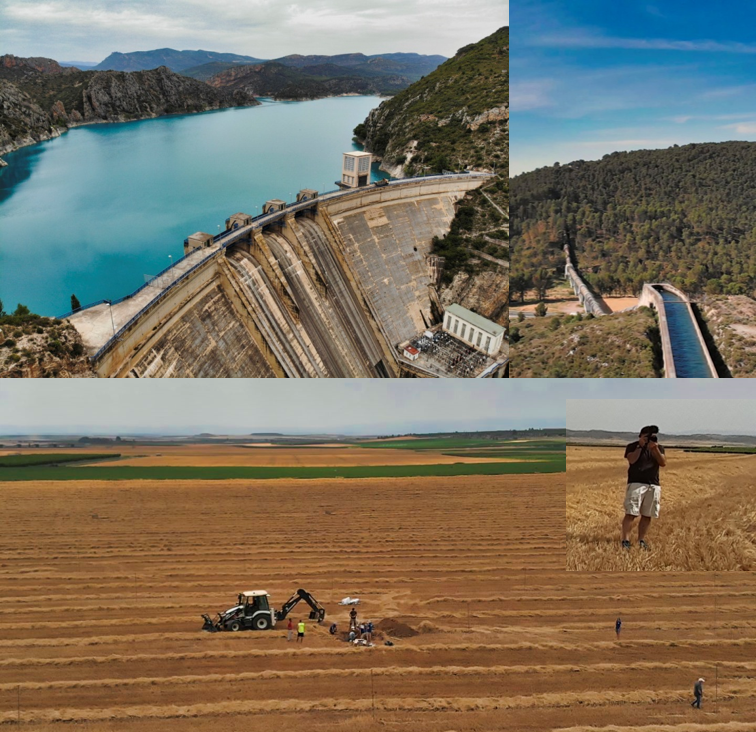
May to August 2021: Three-month stay of Pierre Laluet at LabFerrer, University of Lleida and IRTA (Institute of Agrifood Research and Technology)
My PhD aims at developing a tool to retrieve the dates and quantities of drainage water at the scale of irrigation districts (several tens of thousands of hectares) by combining an agro-hydrological model and remote sensing data. To reach this goal, I am using unprecedented drainage data measured at an integrated scale in drains buried under a large part of the Algerri-Balaguer irrigation district located north of Lleida in Catalonia. It is in this framework and thanks to the ACCWA project (funded by the European Union’s H2020 RISE program) that I got the opportunity to spend three months in Lleida to work on this study area.
Among the many meetings, trainings, field trips, and various encounters, the key elements of my stay are: 1) the installation of four passive lysimeters on two plots, which are now also equipped with meteorological stations and water counters, allowing to calibrate a method at the plot level; 2) the launch of a sampling campaign for isotopic analysis to better understand the flow observed in the buried drains; 3) various trainings received (HYDRUS-1D, passive lysimeters, Sen4ET evapotranspiration products), and trainings given on the SAMIR model; 4) a better understanding of the area (geology, pedology, hydro(geo)logical functioning), and of the realities of the field and its specific challenges; 5) numerous meetings, including with managers of the irrigation district, farmers, the IRTA and LabFerrer teams.
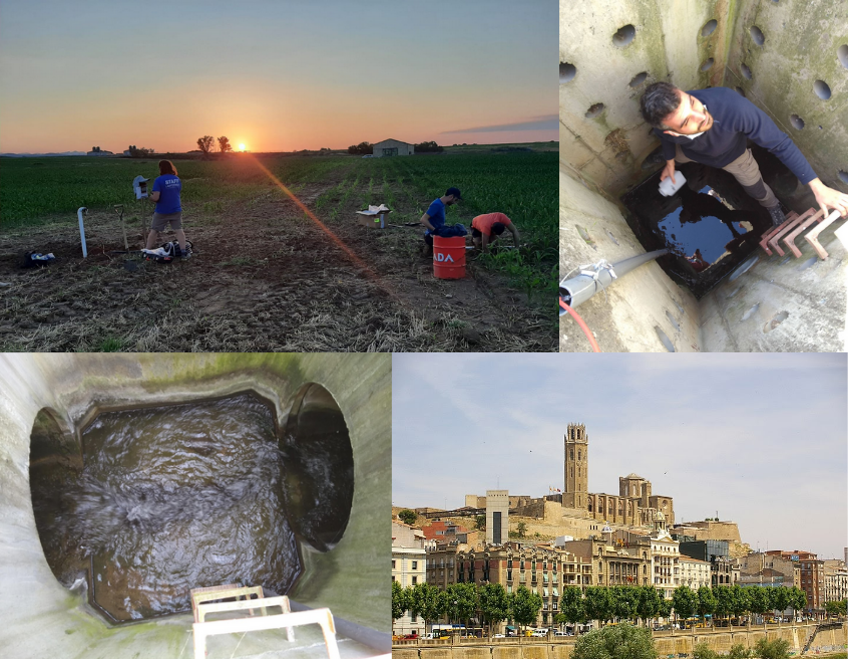
May – August 2021: Three-month stay of Luis Olivera at LabFerrer, University of Lleida and IRTA
Luis Olivera, postdoctoral researcher at CESBIO, was seconded to LabFerrer near Lleida from 16th May to 15th August 2021 as part of the Horizon 2020 Research and Innovation Staff Exchange (RISE) ACCWA project. Among the many field trips realized in the study area, north of Lleida, he took the opportunity to participate together with IDEWA participants in the installation of METER G3 lysimeters and the isotopic measurements campaign in the Algerri-Balaguer area. Luis received a training by IRTA members about the utilization of Sen4ET data. SEN4ET is a high resolution remotely sensed evapotranspiration product that will be assimilated in a crop water balance model (SAMIR for SAtellite Monitoring of IRrigation) to better estimate evapotranspiration, root-zone soil moisture and the irrigation water actually applied over the Algerri-Balaguer district. Additionally, Luis gave a training to IDEWA and ACCWA participants about the SAMIR model for the mapping of water balance components over agricultural areas.
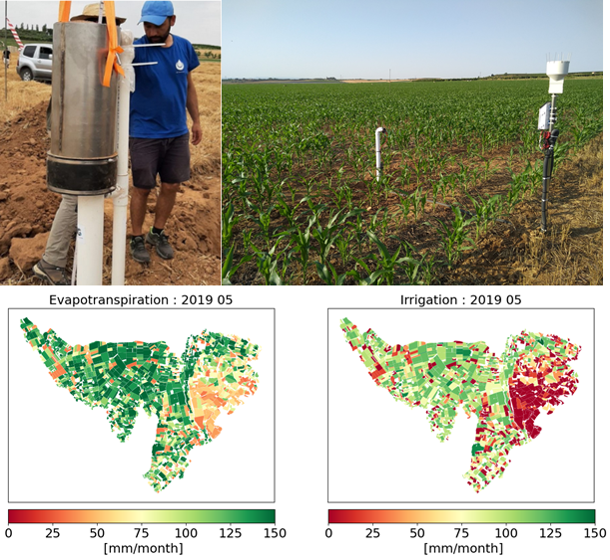
July 2021: Participation to the HILIAISE (Human imprint on Land surface Interactions with the Atmosphere over the Iberian Semi-arid Environment) soil moisture campaign
In July 2021, two members of the IDEWA project, Pierre Laluet and Luis Olivera Guerra, had the opportunity to participate in the intensive measurement campaign of the HILIAISE project, carried out in the framework of the HYMEX (HYdrological cycle in the Mediterranean Experiment) program. This vast experiment involved many laboratories (CNRM, CESBIO, University/ of the Balearic Islands, UK Met Office, LMD-IPSL, Observatori de l’Ebre, IRTA, Wageningen University and Research,…), some of which are members of the IDEWA project, and took place in the Urgell irrigation district located a few tens of kilometers from the IDEWA study (Algerri-Balaguer) area. It is in this context that Pierre Laluet and Luis Olivera Guerra participated in a one-week measurement campaign on 23 different plots, to collect in-situ data of surface soil moisture using TDR probes, and LAI (Leaf Area Index) by taking hemispherical photos. Those measurements will provide reference data for calibration and validation activities. They were carried out on each pass date of the Sentinel-1 satellite (every 6 days) and on each pass date of the airborne GLORI instrument (Zribi et al. 2018), which was flown to estimate surface soil moisture at high spatial resolution by GNSS reflectometry.
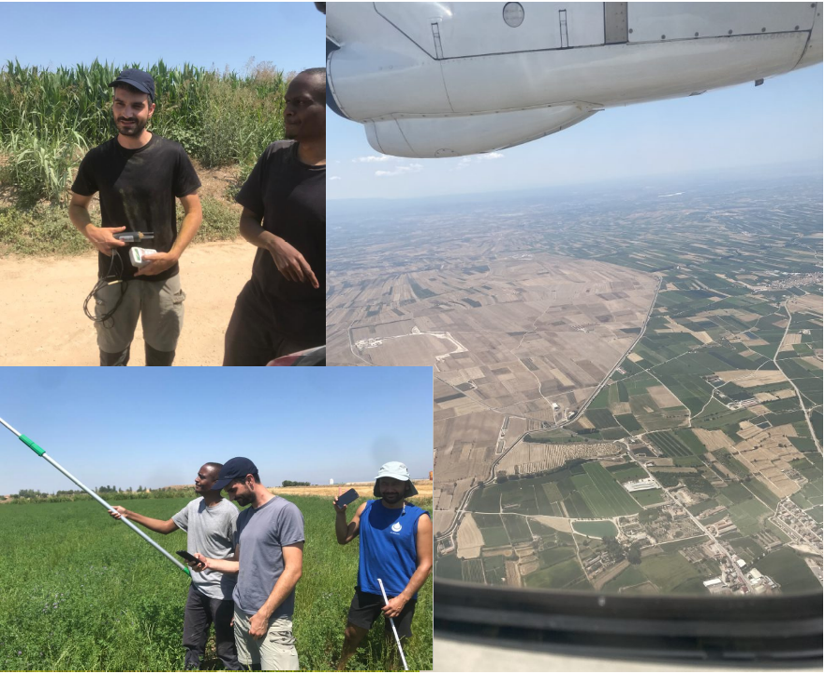
July 2021: Isotopic measurements in Algerri-Balaguer
A new experimental protocol was proposed in the frame of IDEWA in collaboration with Nicolas Patris from Hydro Sciences Montpellier lab. The science question here is to trace the origins of the drained water measured at the wells of Algerri-Balaguer district, i.e. to determine the partitioning of the drained volume that comes from irrigation water and the drained volume that comes from natural precipitations. Addressing this key issue will greatly help validate model estimates at the integrated scale –several thousand of hectares- of the drainage measurements. A possible solution to this problem is to use isotopic techniques to try and trace back the water pathways from the measurement of the isotopic composition of water molecules. This experiment started in July 2021 and is planned to last for at least 12 months. It involves the collection of water samples once per month in different reservoirs (raingauges, irrigation reservoir, drain wells and lysimeter drainage bottles) by the University of Lleida team.
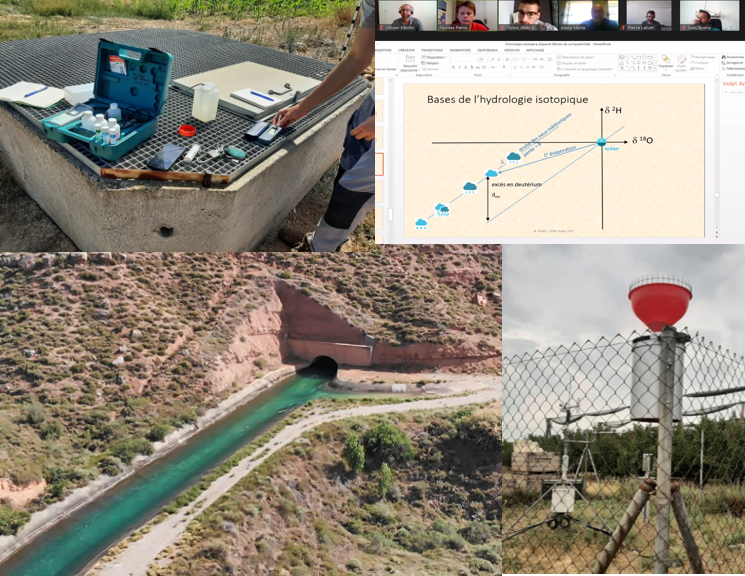
June 2021: Installation of METER G3 lysimeters in Algerri-Balaguer
One main objective of IDEWA is to monitor and predict the water drainage below the root zone over irrigated areas. Modeling tools of the crop water budget, like SAMIR (Satellite Monitoring of Irrigation) model, operate at the scale of agricultural practices. There is thus a need to assess SAMIR drainage estimates at the crop field scale. To meet this need, four passive G3 type lysimeters were installed in two experimental fields of Algerri-Balaguer, occupied by corn and wheat crops respectively. The installation took place on 16th and 28th June 2021. It was made so efficient by the help and know-how of LabFerrer team and the excavator kindly lent by the Canal Algerri-Balaguer irrigation agency. LabFerrer is collaborating with several IDEWA partners as part of the ACCWA consortium.
